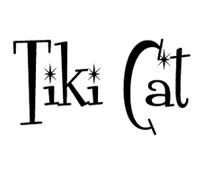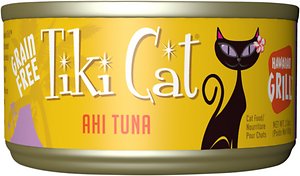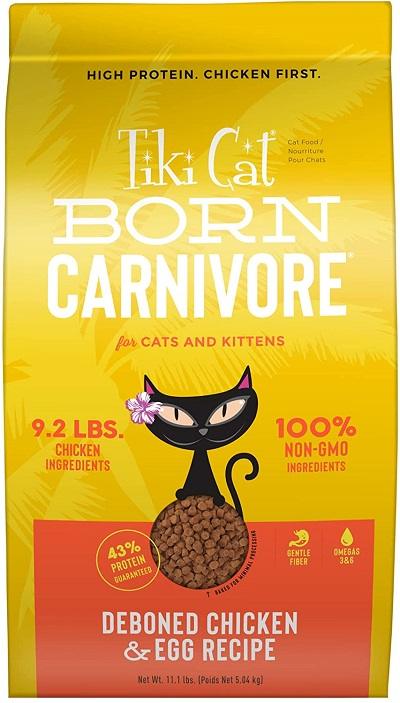
Tiki Cat is celebrated as one of the most radically carnivore-appropriate brands on the market, but is it a safe, nourishing choice for your cat? Find out in our unbiased Tiki Cat review.
The Cats.com Standard—Rating Tiki Cat On What Matters
We’ve analyzed Tiki Cat and graded it according to the Cats.com standard, evaluating the brand on species-appropriateness, ingredient quality, product variety, price, customer experience, and recall history. Here’s how it rates in each of these six key areas.
Ratings
- Species-Appropriateness – 4/5
- Ingredient Quality – 5/5
- Product Variety – 3/5
- Customer Experience – 4/5
- Recall History – 5/5
Overall Score: 4.2/5
We give Tiki Cat a 21 out of 25 rating or a B grade.
Why Trust Cats.com
I’ve done hours of research on Tiki Cat food, studying the brand’s recall history, manufacturing, ingredient quality, and customer experience. On top of those hours of screen time, I did some paws-on testing.
To get a sense of what this food is like, I bought a bag of Tiki dry cat food and two flavors of wet cat food—all at full retail price. The paws-on testing was done with my cats, so I could get a sense of how real cats truly feel about the food.
About Tiki Cat
A company called Petropics owns Tiki Cat. Before founding Petropics, Christine Hackett worked in research and development for Petco. While working with the retailer’s private label program, she became increasingly aware of the problems and potential in the pet food industry. In 2005, Christine and her husband, Robert, founded a pet food company of their own.
“A lot of midline premium brands, which still have a lot of grain and carbohydrates in them, lost traction to companies like mine,” Christine said in an article in The New York Times. Indeed, Tiki Cat has gained a following with its low-carbohydrate recipes, some of which are made from nothing but meat and supplements.
Since 2015, Tiki Cat has been a part of Whitebridge Pet Brands, a company formed by the merger of Cloud Star and Tiki Pet. Other brands in the Whitebridge portfolio include Dogswell, Catswell, and Buddy Biscuits.
Sourcing and Manufacturing
Tiki Cat is made in Thailand and describes their manufacturing facilities as “award-winning human-grade canning plants.” These facilities meet international standards for human food production.
Tiki Cat explains that they source ingredients as close to their manufacturing plant as they can, including fish from Thai waters. Their fisheries are part of the International Seafood Sustainability Foundation (ISSF) and support conservation initiatives that help to protect marine environments. They’re certified by the International Dolphin Conservation Program, which aims to protect dolphins from tuna fishing.
Has Tiki Cat Cat Food Been Recalled?
Tiki Cat has never been recalled.
What Kinds of Cat Food Does Tiki Cat Offer?
Tiki Cat focuses on wet food with a wide variety of canned and pouched recipes. They also offer a small selection of dry cat food. In total, the brand offers over 40 different flavors and textures.
Here’s a quick overview of the ten product lines Tiki Cat has to offer:
- After Dark – A line of wet food that combines muscle meat and nutrient-rich organs.
- Aloha Friends – A line of wet foods made with chicken or tuna and supplemented with pumpkin.
- Born Carnivore – A limited selection of baked kibble diets that offer 44% protein on average and are made without potatoes, corn, rice, or wheat.
- Essentials – This line includes two animal-based dry food recipes made with chicken, turkey, trout, and menhaden fish meal.
- Grill – A line of wet foods made with fish-based proteins and garnished with shellfish like shrimp and prawns.
- Luau – This line includes a variety of canned foods made primarily with shredded chicken and flaked fish like wild salmon and ahi tuna.
- Velvet – A line of smooth mousses for cats who like to lap up their meals.
- Kitten/Senior – These two lines include stage-specific recipes for kittens and seniors.
- Special – A limited selection of mousses formulated to support specific health goals such as weight loss, healthy digestion, and skin & coat health.
- Raw – A line of five raw food recipes made with premium animal proteins and bone broth, free from added carbohydrates.
All Tiki Cat recipes are free from animal by-products, grains, and potatoes. They’re made without artificial colors, flavors, and preservatives.
In addition to these complete and balanced recipes, Tiki Cat offers an assortment of treats and food toppers. Tiki Cat Broths, Complements, Special, and Velvet food toppers are rich in moisture and natural flavor. As far as treats go, Tiki Cat offers soft and chewy treats, crunchy treats, wet treat sticks, and fish fillets.
What Did Our Test Cats Think?

Kirsten McCarthy / Cats.com
Tiki Cat’s wet foods are some of the most protein-rich, low-carbohydrate products on the market. With some of their foods offering zero carbohydrate content, Tiki Cat foods are an excellent option for cats with diabetes or IBD. In particular, the After Dark line is an outstanding choice. It’s a line of species-appropriate food combining both muscle meat and organs for a wide spectrum of animal-sourced nutrients.
Their dry foods are—like virtually all dry foods—relatively high in carbohydrates and fail to deliver the moisture cats need, but they’re better than the average kibble, offering significantly higher meat inclusions and lower carbohydrate content.
Considering that the brand has never been recalled, Tiki Cat appears to be both nutritionally superior and trustworthy. On the negative side, Tiki Cat foods are more expensive than most. You might spend close to $5 per day to feed your cat one of the brand’s wet recipes. Multiple cat homes or those with large or active cats will spend even more. To see how our cats felt about the food, we bought the products at full retail price, and Cats.com funded the entire testing process without direct input or influence from the companies involved.
Tiki Cat – Top 3 Recipes Reviewed
| Product Name | Food Type | Price | Our Grade |
| Tiki Cat Puka Puka Luau Succulent Chicken in Chicken Consommé | Wet | $0.65 per oz | B+ |
| Tiki Cat Hawaiian Grill Ahi Tuna Grain-Free Canned Cat Food | Wet | $0.48 per oz | B+ |
| Tiki Cat Born Carnivore Chicken Luau Grain-Free Dry Cat Food | Dry | $6.19 per lb | B- |
What Do Customers Think of Tiki Cat Food?
Tiki Cat food receives overwhelmingly positive reviews. Customers like the food’s low carbohydrate content and simple recipes. The brand is popular among cats with IBD, diabetes, and other sensitivities. The Grill and Luau lines are particularly popular, while After Dark receives mixed reviews.
In 2018, an unusual complaint started popping up in customer reviews. Several buyers report finding gray meat in their cans of Tiki Cat. The company maintains that the gray color is a normal result of cooking and doesn’t affect the food’s safety.
Reviews seem to back the company up on this—it doesn’t appear that any cats have gotten sick after eating the discolored Tiki Cat food.
Positive Reviews
“My 16 year old kitty was becoming finicky and losing weight. We bought this food and no more finicky eater! His coat looks nicer too. Wish I’d found it sooner!” EATahoe, reviewing Tiki Cat Hawaiian Grill Ahi Tuna, on Chewy, on July 24, 2023
“As in transitioning off kitten food and into adult food, I was worried that my cats wouldn’t like new kibble but they didn’t hesitate to eat this. Helps with their digestive problems and still comes in small bite size pieces. A little on the pricier side but cheaper than any of the other grain free options I’ve seen.” Josie, reviewing Tiki Cat Born Carnivore Indoor Health, Chicken & Turkey Grain-Free Baked Kibble, on Amazon, on October 5, 2023
The majority of the positive reviews focused on just how much picky cats love eating Tiki Cat food. Cat owners were impressed with the quality of the ingredients. They also noted how great their cat’s fur looked after switching to Tiki Cat foods.
Negative Reviews
“I purchased the eight pack of 6 oz cans for my mothers cat. I open the cans and leave in frig, she then warms up and feed Kate. Parent is 89 and visually impaired, Kate is 16. Got a call that Kate had thrown up. Looked at food the next day. While it smelled ok, it wasn’t what you think of as canned tuna. It was very very dark brown with white specs. Just looks bad. Called tiki cat. I would suggest calling Chewy rather than Tiki cat. They say they will send a coupon.” Gyzmo, reviewing Tiki Cat Hawaiian Grill Ahi Tuna, on Chewy.com, on September 25, 2023
“Cats wouldn’t eat it. Was looking for a wet food with zero chicken which is really difficult. I thought the flavors sounded interesting and tried something new. Too bad I had to get a 12 pack because now after trying 3 flavors I give up. they gave it one lick and walked away and now my apartment smells like fish.” Rockysmom, reviewing Aloha Friends Variety Pack, on Chewy.com, on August 30, 2023
Negative reviews voiced concerns over the food’s strong scent or odd texture. A few reviewers pointed out that their cats simply didn’t like the food. Others mentioned that the containers came dented or the packages were broken.
How Much Does Tiki Cat Cost?
Tiki Cat isn’t the cheapest brand on the market, but their dry foods are fairly affordable. The average cost for Tiki Cat wet food ranges from about $0.35 to $0.55 per ounce. For a 10-pound cat, it would cost between $2.96 and $5.00 per day to feed the recipes reviewed above.
Like most cat food companies, Tiki Cat prices their dry food lower than their wet recipes. Tiki Cat Born Carnivore dry food costs about $0.50 per day.
In terms of price and quality, Tiki Cat is on par with other premium brands like Koha and Hound & Gatos. It’s less expensive than one of our favorite brands, Ziwi Peak.
Overall, Is Tiki Cat a Good Choice?
Tiki Cat’s wet foods are some of the most protein-rich, low-carbohydrate products on the market. With some of their foods offering zero carbohydrate content, Tiki Cat foods are an excellent option for cats with diabetes or IBD. In particular, the After Dark line is an outstanding choice. It’s a line of species-appropriate food combining both muscle meat and organs for a wide spectrum of animal-sourced nutrients.
Their dry foods are—like virtually all dry foods—relatively high in carbohydrates and fail to deliver the moisture cats need, but they’re better than the average kibble, offering significantly higher meat inclusions and lower carbohydrate content.
Considering that the brand has never been recalled, Tiki Cat appears to be both nutritionally superior and trustworthy. On the negative side, Tiki Cat foods are more expensive than most. You might spend close to $5 per day to feed your cat one of the brand’s wet recipes. Multiple cat homes or those with large or active cats will spend even more.
Where To Buy Tiki Cat?
Tiki Cat is available in independent pet stores and chains. Use their store locator to find a retailer near you. You can buy it from PetSmart, Petco, Chewy, Amazon, Walmart, and other online retailers that sell cat food.



